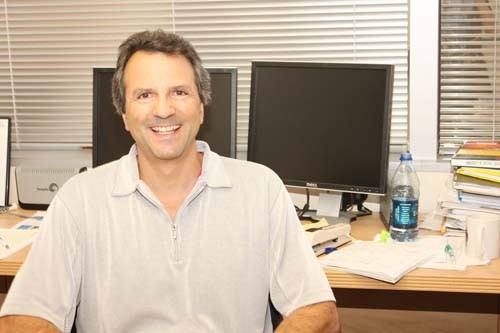Jon Chorover is a professor of soil, water and environmental science and principal investigator for the “”Critical Zone Observatory.”” He also serves joint appointments in the departments of Geosciences and Hydrology.
Chorover is a Boston native who attended the University of Michigan for his Bachelor of Science degree in environmental science. He attended the University of California, Berkeley for graduate school, where he obtained a masters degree in forest science and a doctoral degree in soil chemistry. He was a faculty member at Penn State for six years prior to coming to the UA in 2001.
The Daily Wildcat sat down with Chorover to discuss his work on the development of a research base to study the effects of climate change on what is called the “”critical zone.””
The National Science Foundation recently gave the UA a $4.35 million grant to study the critical zone. As the principal investigator on this project, what can you tell about the critical zone?
The critical zone is defined as the part of earth’s surface that expands from the treetops to the bottom of the ground water or the lowest limit of groundwater.
It’s critical for providing us with clean water, because the zone can be considered as a filter in the hydrologic cycle. It filters water, weathers rock and provides nutrients to ecosystems. The zone essentially mediates the hydrologic cycle. It’s the land portion of the cycle that controls the rate at which water is delivered from precipitations into aquifers or streams where society tends to harvest that water. It functions as a complex part of earth’s structure critical for sustaining life on earth.
How many researchers are involved in the study?
I’m a representative of 12 faculty members at the UA involved. This has really been a team project with all of those faculty members. The faculty is from two different colleges: the college(s) of Science and Agriculture and Life Sciences and many of the faculty are within the newly formed School of Earth and Environmental Science.
The faculty is also going to have students and researchers working with them. It will probably be on the order of 20 graduate students involved and we will also have undergraduates involved.
Where will the observatory be located?
The National Science Foundation funded us to develop an observatory located in northern New Mexico in the Jemez river basin and in the Santa Catalina Mountain basin. Both mountains are focused in the Southwest, where water is at a premium. Our mountain areas tend to be areas that get most rainfall in the Southwest and are essential to provide water to our growing cities. We are focusing on processes that influence that transmission of rainfall and the transport of rainfall into rain supplies in aquifers or streams.
How is this study different from studies in the past?
In the past people have studied different parts of the zone in their fields but they haven’t looked at how all these different components of the critical zone are linked to its function to help better understand how the whole zone functions. This research project is important because of the interdisciplinary nature of the studies and experiments we will be doing.
Our project is a good example of the interdisciplinary research you can do when you have faculty members from a variety of complementary, but normally distinct, disciplines all working together.
Why is this study important to Arizona?
Of particular importance (to people) living in the desert is the behavior of water and the role of climate and the water cycle. Predictions for the Southwest are it will become drier and hotter under climate change. That makes this work all the more important because we are using climate gradients. For example, how the zone functions as you go down from low elevation of the Sonora Desert to the top of the Catalina’s pine and fir zone.
By studying the critical zone along that climate gradient we can start understanding how, if the Southwest gets hotter and drier over time, how that will influence the zone and both the quality and quantity of water for human use. It’s extremely important to do these studies in the desert and in the rain forest as well-any place on the globe we are likely to see climate change in the future because we need to know how the critical zone will respond to changes in climate.
This project is also closely affiliated and linked to Biosphere 2 in that much of the research we are doing as part of the “”Critical Zone Observatory”” will be on display at the Biosphere 2 and scientists doing research at Biosphere 2 are also involved with this research.









